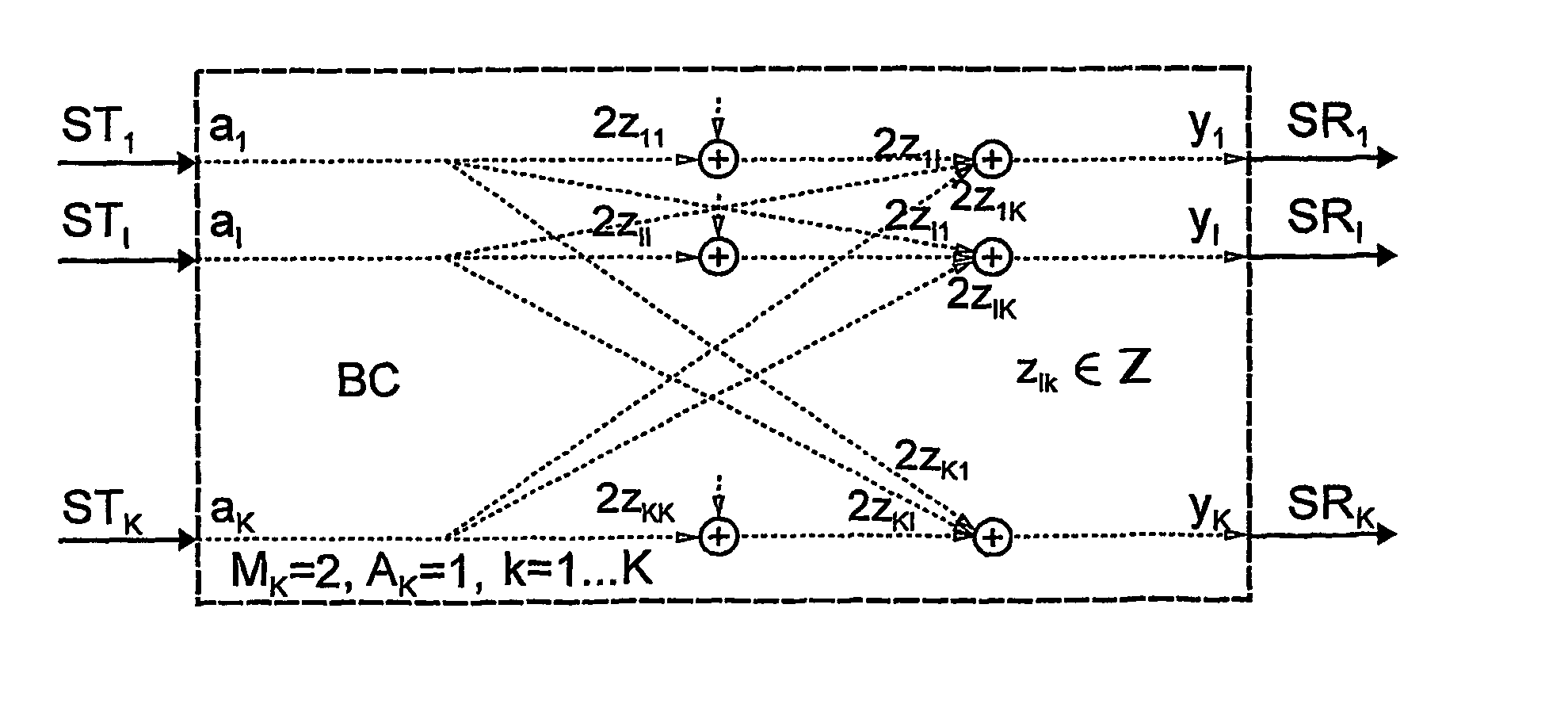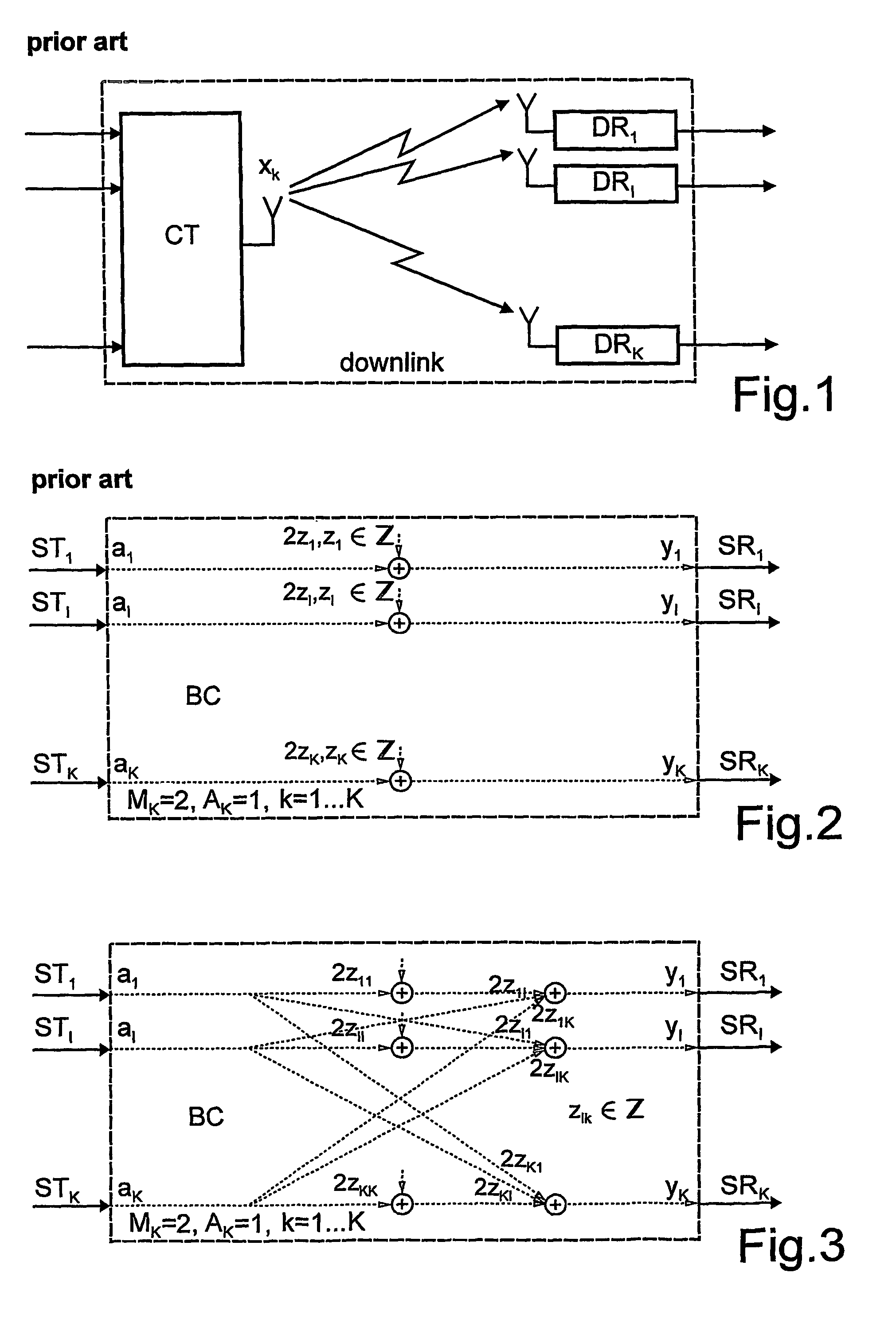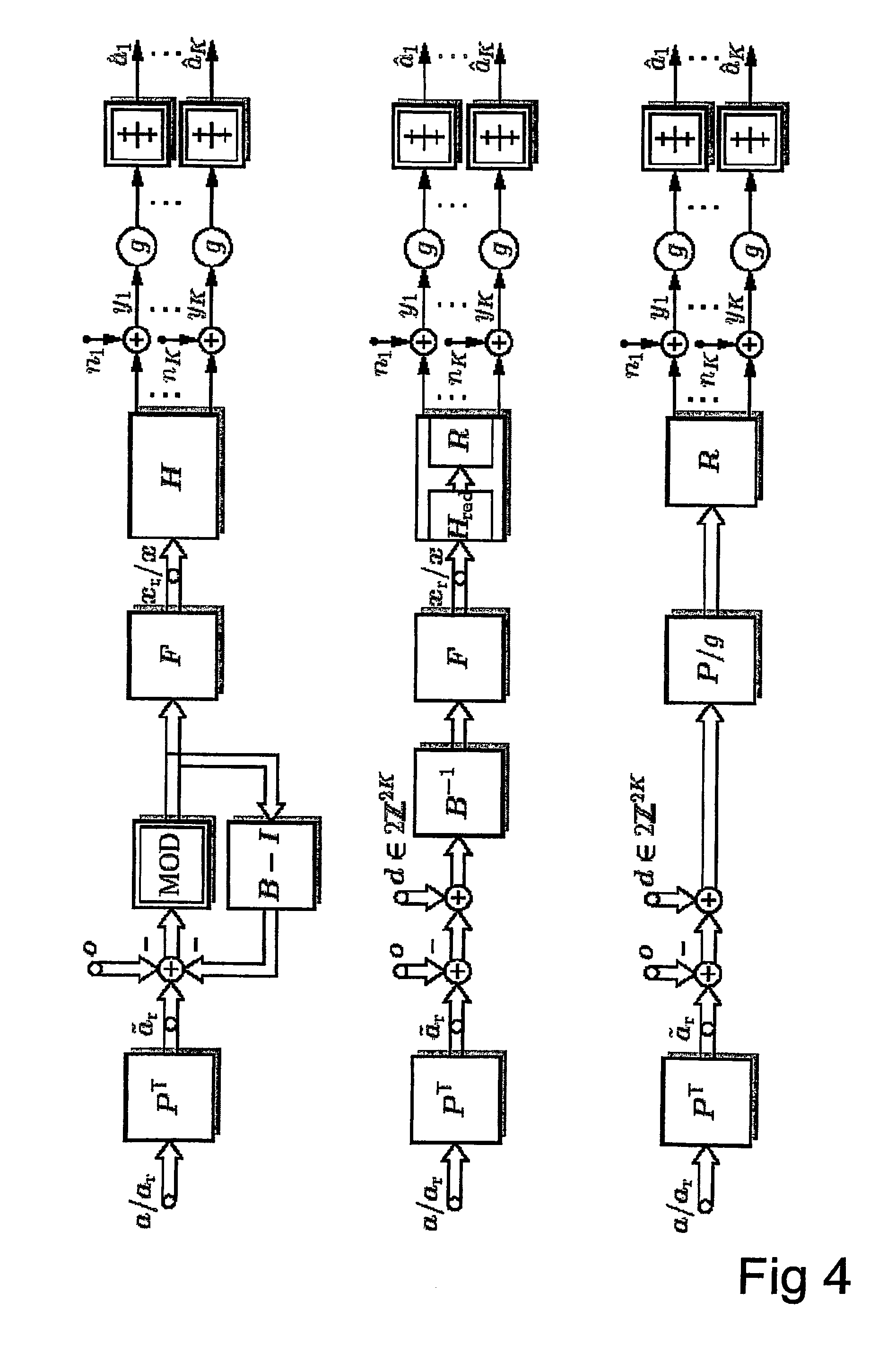[0018]In order to simplify the equalization and advantageously utilize the possible diversity, with the preceding method according to the invention the broadcast channel present is notionally subdivided into two sections. The first part is completely equalized by preceding, the user signals are therefore decoupled, but a periodic continuation of the data symbols takes place. The current representative vk for the data symbols ak is selected on an ongoing basis from the possible values which differ by integral multiples of the original level number Mk, so that after linear preequalization of the selected representatives vk the required transmit power is minimal. The second part of the channel is not equalized and therefore produces residual interference between the user signals. By suitably selecting this part, however, it can be achieved that, on the one hand, the residual interference is so constituted that it does not adversely affect decision making in the receivers and, on the other, that equalization of the first part of the channel is possible with lower receive-side gain and therefore lower noise amplification or the diversity of the channel can be at least partially utilized. Since when using preequalization methods the user signals already appear periodically continued at the receivers, the residual interference may assume values coinciding with the spacing of the possible representatives, the interference being reflected only in the (virtual) selection of a different representative, and its effect being completely eliminated in the modulo decision device already present. The crucial advantage of the invention is the greatly increased power efficiency of signal transmission. By the preceding method, a lower bit error rate, i.e. reliable reception, can be achieved at the same average transmit power as with the known precoding methods. In particular, using the precoding method, a diversity gain can be obtained which makes itself positively felt in a more rapid reduction in the bit error rate as the transmission quality of the broadcast channel improves.
[0019]A partial equalization of the transmission channel corresponds to using a changed channel description, in mathematical terms converting the channel matrix Hr to a reduced channel matrix Hred. Its multiplication with a suitable residual interference matrix R describing the remaining mutual couplings then yields once again the channel matrix Hr according to the decompositionHr=RHred.
[0020]The residual interference matrix R is only dependent on the current transmission behavior of the channel. As long as the channel matrix H (or Hr) does not change (burst transmission), the residual interference matrix R does not change either. On the main diagonal the residual interference matrix R is occupied by ones (direct signal paths), all the other elements assume row-wise only integral (positive or negative) multiples of the level number Mk. In the case of binary transmission per component, these elements are only even (positive or negative) numbers:
[0022]Various methods can be used for suitable decomposition of the channel matrix H. By using the Monte Carlo method, the appropriate coefficients can be determined e.g. empirically. Optimum decomposition methods must be selected for their complexity, which should be as low as possible, and for required receive-side gain that is as small as possible (e.g. by Automatic Gain Control AGC).
[0023]Other matrix reductions for MIMO channels are known from the related art as lattice reduction. In publication V by H. Yao et al.: “Lattice-Reduction-Aided Detectors For MIMO—Communication Systems” (Proceedings of IEEE Globecom 2002, Taipei, Taiwan, November 2002) there is described a low-complexity detection method for channels with a plurality of inputs and outputs. The basic idea is the use of mathematical methods which are known from the field of lattice theory (theory of regular lattices), the MIMO channel not being linearly equalized completely but, on the basis of another, more suitable representation (reduced basis), the channel is only partly equalized so that a simple component-wise (i.e. in respect of the individual user signals) threshold decision is possible. Only after further postprocessing are the required estimated values for the transmitted data signals obtained. However, the known method specifically considering the case of two transmitting and two receiving antennas differs fundamentally from the invention in that there, in a multi-antenna system, all the user receive signals are known on the receive side and joint signal processing is possible. In contrast to this, the precoding method according to the invention relates to the problem in a multiuser system with exclusively downlink direction. Here a common transmitter is present at which all the user signals are known and can be processed. On the other hand, the receivers scattered over a service area cannot cooperate, i.e. each receiver sees only its own receive signal (no joint processing possible). The known (partial) equalization takes place exclusively on the receive side on an exclusively linear basis, i.e. the reduced portion of the channel is equalized using the inverse channel matrix. The invention operates exclusively nonlinearly on the transmit side on the basis of THP.
[0024]Publication VI of Ch. Windpassinger and R. Fischer: “LowComplexity Near-Maximum-Likelihood Detection and Precoding for MIMO Systems using Lattice Reduction” (Proceedings of IEEE Information Theory Workshop 2003, pp. 345-348, Paris, France, March / April 2003) is based on and expands publication V. The low-complexity detection method for MIMO channels with a plurality of inputs and outputs is extended from the 2×2 scenario to the general case of K inputs and outputs. In addition, the linear partial equalization is replaced by a nonlinear preceding. However, the critical difference from the invention is that these methods again relate to multi-antenna systems in which all the partial receive signals are known on the receive side and joint processing is possible. The preequalization method of the present invention is, on the other hand, designed for decentralized receivers that cannot cooperate, wherein lies a particular difficulty for signal processing, because it can only take place on the transmit side.
 Login to View More
Login to View More  Login to View More
Login to View More 


